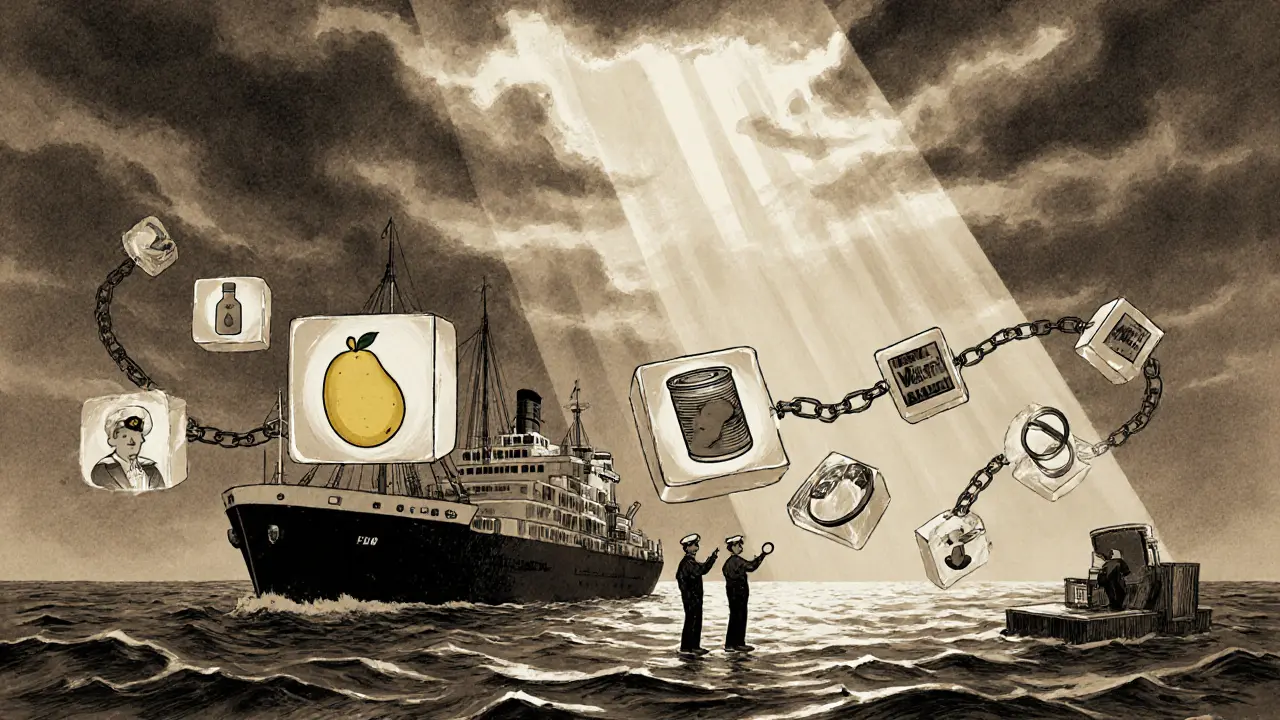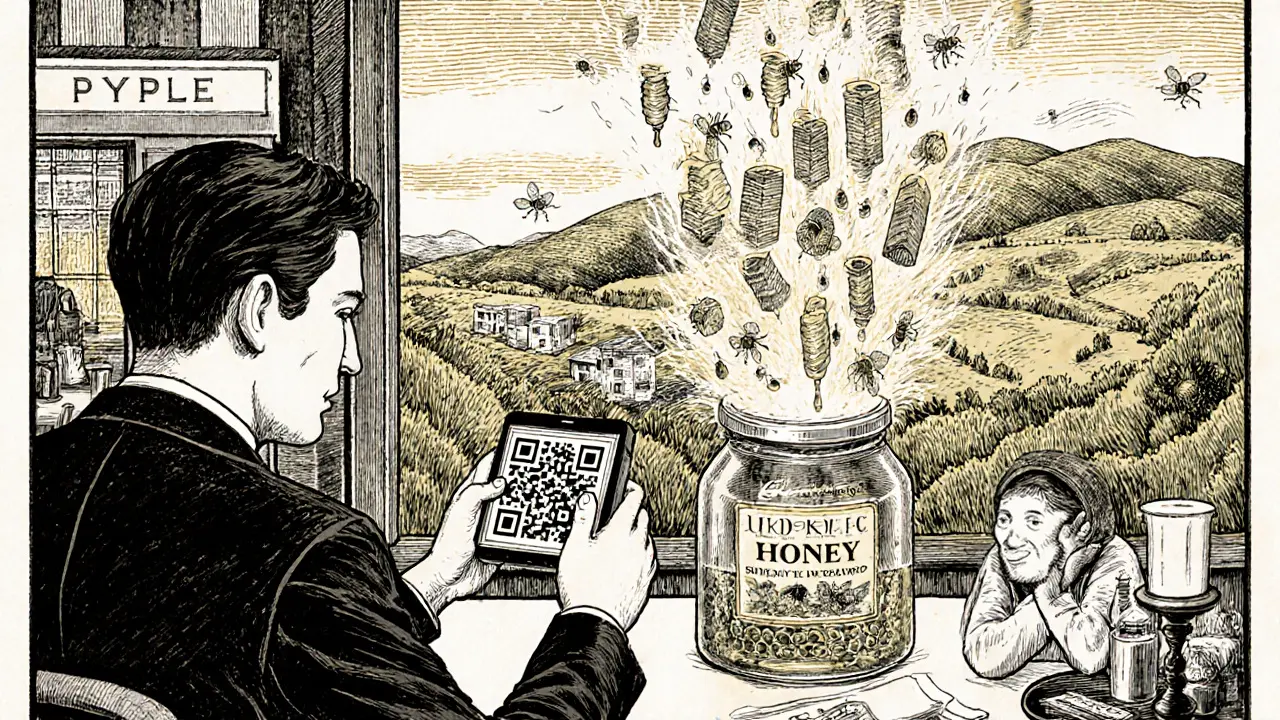Supply Chain Transparency Calculator
Calculate potential improvements for your supply chain using blockchain technology. Based on real-world implementations from the article.
Estimated Blockchain Impact
Recall Resolution Time
From 7 days to 12 seconds
Fraud Reduction
Potential reduction of 98%
Cost Savings
Save $3,000 per transaction
Imagine you buy a bag of coffee labeled "fair trade" and "single origin." But how do you really know it came from that small farm in Colombia? Was it mixed with cheaper beans halfway across the world? Who handled it? Was it stored properly? Traditional supply chains don’t give you answers - they give you paperwork. And paperwork can be lost, altered, or simply ignored.
That’s where blockchain comes in. It’s not just about cryptocurrency. At its core, blockchain is a shared, unchangeable digital record that tracks every step of a product’s journey - from raw material to your hands. For supply chains, this isn’t a nice-to-have upgrade. It’s a complete overhaul of how trust is built.
How Blockchain Solves Supply Chain Problems
Supply chains are messy. They involve dozens - sometimes hundreds - of companies across multiple countries. Each one keeps its own records. A shipment might pass through 15 different systems before reaching the final buyer. If something goes wrong - say, contaminated food or stolen electronics - finding the source takes weeks, if not months.
Blockchain fixes this by creating one shared version of the truth. Every time a product changes hands - from farmer to processor to shipper to retailer - that event is recorded as a block on the chain. Once added, it can’t be deleted or changed. No single company controls the ledger. Instead, every participant has a copy. If someone tries to fake a document, the system instantly flags the mismatch.
This isn’t theory. In 2024, a major food retailer in New Zealand traced a batch of spoiled mangoes back to a single farm in 12 seconds. Before blockchain, that process took 7 days. The difference? One system. One record. One truth.
The Four Technical Pillars of Blockchain in Supply Chains
Blockchain works because of four key features that traditional databases simply can’t match.
- Immutability: Once data is added, it’s locked in. No backdating. No editing. No deleting. This prevents fraud and ensures records stay accurate over time.
- Decentralization: No central server. No single point of failure. If one company’s system goes down, the rest of the network keeps running.
- Distributed Ledger: Every participant sees the same data in real time. No more arguing over who sent what, when, or where.
- Cryptographic Security: Each transaction is signed with a digital key. Only authorized parties can add or view data. This keeps sensitive info like pricing or supplier names private while still proving authenticity.
Together, these features turn supply chains from opaque black boxes into transparent, auditable flows. It’s like giving every product a digital passport that follows it everywhere.
Smart Contracts: The Automatic Enforcers
Blockchain doesn’t just record data - it can act on it. That’s where smart contracts come in.
A smart contract is a self-executing piece of code. It runs automatically when certain conditions are met. For example:
- If a shipment of pharmaceuticals arrives at a warehouse and the temperature log shows it exceeded 8°C, the contract automatically flags it for quarantine and notifies the supplier.
- If a farmer delivers organic cotton certified by a trusted third party, the contract releases payment instantly - no invoices, no delays.
- If a luxury handbag’s serial number matches the blockchain record, the customer gets a digital certificate of authenticity.
This cuts out paperwork, reduces human error, and speeds up payments. Companies using smart contracts report up to 40% faster settlement times and fewer disputes.

Real-World Success Stories
It’s not just hype. Real companies are seeing results.
Renault Group moved all its supplier documentation onto a blockchain network - and invited every other carmaker to join. Now, parts from 500+ suppliers are tracked end-to-end. If a faulty airbag is found, they know exactly which vehicles are affected - down to the VIN number.
In the seafood industry, companies in Australia and New Zealand use blockchain to prove their tuna is sustainably caught. Consumers scan a QR code on the can and see the exact fishing vessel, date, location, and even the captain’s name. Sales jumped 22% after the launch.
IBM’s blockchain platform helped a global pharmaceutical company reduce counterfeit drug incidents by 98% in just 18 months. Every pill bottle now has a unique digital ID that can’t be copied.
Even small businesses are benefiting. A New Zealand honey producer now uses blockchain to prove its product is 100% pure. Customers can see the hive location, extraction date, and lab test results. They’re charging 30% more - and customers are happy to pay.
Why Most Companies Still Struggle to Adopt It
Despite the benefits, adoption is slow. Why?
First, it’s not plug-and-play. Integrating blockchain with old ERP systems takes months. Many companies have decades-old software that wasn’t built for real-time data sharing.
Second, it’s a team sport. One company can’t do it alone. You need suppliers, logistics partners, regulators, and auditors all on the same network. Convincing them to share data - especially competitors - is hard.
Third, there’s no universal standard. One company uses Hyperledger. Another uses Ethereum. Another uses Oracle’s system. They don’t talk to each other. Until industry groups like GS1 agree on common data formats, interoperability will remain a headache.
And then there’s cost. Setting up a permissioned blockchain (the kind businesses use) requires skilled developers, ongoing maintenance, and training. Small suppliers often can’t afford it - which creates a new kind of inequality in the supply chain.

What You Need to Get Started
If you’re considering blockchain for your supply chain, here’s what actually matters:
- Start with a clear problem. Don’t adopt blockchain because it’s trendy. Ask: Where are we losing time? Where do we get fraud? Where do customers lose trust?
- Choose the right platform. IBM’s Hyperledger Fabric, Microsoft Azure Blockchain, and Oracle Blockchain Platform are enterprise-ready. Avoid public blockchains like Bitcoin - they’re too slow and too public for business use.
- Define your data rules. What exactly gets recorded? Product ID? Temperature? Location? Shipping time? You need to agree on this with all partners before you begin.
- Start small. Pilot with one product line or one supplier. Prove the value before scaling.
- Train your team. Your logistics staff won’t understand smart contracts. You’ll need internal champions who can bridge tech and operations.
Most successful projects take 6 to 12 months from idea to live system. But the payoff? Faster recalls, fewer counterfeits, stronger customer trust, and compliance with new laws like the EU’s Digital Product Passport.
The Future: More Than Just Tracking
Blockchain is evolving. New tools are making it smarter and greener.
Zero-knowledge proofs let companies prove something is true - like “this shipment met carbon standards” - without revealing the actual data. That’s huge for competitive industries.
IoT sensors now automatically feed real-time data into the blockchain. A refrigerated truck’s temperature? Logged every 30 seconds. A shipping container’s location? Updated via satellite. No manual entry needed.
And AI is stepping in. Algorithms analyze blockchain data to predict delays, spot fraud patterns, or flag suppliers with a history of compliance issues.
In five years, blockchain won’t be a flashy tech experiment. It’ll be the invisible backbone of global trade - like electricity or the internet. Companies that don’t use it won’t just be behind. They’ll be excluded.
Transparency isn’t optional anymore. Customers demand it. Regulators require it. Investors expect it. Blockchain is the only technology that delivers it at scale - without trusting anyone too much.
Can blockchain prevent counterfeit goods in supply chains?
Yes. Every product gets a unique digital fingerprint stored on the blockchain. If someone tries to sell a fake, the system checks the record and immediately shows it doesn’t match the original shipment. Companies like Louis Vuitton and pharmaceutical firms use this to stop counterfeits before they reach customers.
Is blockchain only for big companies?
No. While large firms lead adoption, smaller suppliers can join existing networks built by bigger partners. For example, a small coffee farm in Colombia can join a blockchain network created by a major coffee importer. The farm doesn’t need to build the system - just use the tools provided. Many platforms now offer low-cost entry tiers for small businesses.
Does blockchain make supply chains slower?
Not anymore. Early blockchains were slow, but modern enterprise versions handle thousands of transactions per second - faster than many legacy systems. Plus, automation through smart contracts cuts delays from days to minutes. The real bottleneck isn’t the tech - it’s getting everyone to use it.
How does blockchain help with sustainability claims?
It proves them. Companies can’t just say they’re "carbon neutral" - they have to show it. Blockchain links every ton of CO2 emitted to a specific shipment, factory, or transport route. This makes ESG reporting accurate and verifiable. Brands using this see higher scores from sustainability rating agencies and more consumer trust.
What happens if the data entered is wrong?
Blockchain doesn’t fix bad data - it just makes it permanent. That’s why data quality matters more than ever. If a supplier falsely claims their cotton is organic, that lie gets locked in. That’s why leading networks require third-party verification before data is added. The blockchain doesn’t lie - but the people entering data still can. That’s why audits and trusted validators are essential.
Are there legal risks with blockchain in supply chains?
Yes. Different countries have different rules about data storage, privacy, and digital signatures. A blockchain record stored in the U.S. might violate GDPR if it contains EU customer data. Companies must design their networks with legal compliance in mind - including who can access what, where data is stored, and how long it’s kept. Legal teams need to be involved from day one.

Eliane Karp Toledo
November 2, 2025 AT 20:47Blockchain? More like blockchain *bogus*. They're just replacing paper trails with encrypted paper trails that only the big guys control. Who's auditing the auditors? If a farm says their coffee is 'organic' but the sensor was hacked? Too bad. The blockchain doesn't care. It just records the lie forever. This isn't transparency-it's digital dogma.
Phyllis Nordquist
November 3, 2025 AT 17:53While the technical architecture of blockchain offers undeniable advantages in immutability and distributed consensus, it is critical to recognize that its success is contingent upon the integrity of the data input. The system is only as trustworthy as the entities that populate it. Therefore, robust third-party verification protocols must be integrated at the point of data ingestion to mitigate the risk of systemic misinformation.
Jason Coe
November 4, 2025 AT 15:02Look, I used to think blockchain was just crypto hype, but I work in logistics and we rolled out Hyperledger for one product line last year. The difference? We cut our recall response time from 5 days to 3 hours. No more guessing which warehouse got the bad batch. My team used to spend half their week chasing paper receipts. Now they just scan a QR code. Yeah, the setup was a pain. Yeah, some suppliers complained. But once they saw the money saved on disputes and insurance? They shut up and joined. It’s not magic-it’s just better record keeping.
Brett Benton
November 5, 2025 AT 20:59Bro, imagine if your avocado toast came with a blockchain passport. You scan it, and boom-you see the farm, the rain it got, the guy who picked it, and how many miles it flew. That’s not tech, that’s soul. People want to know where stuff comes from now. This isn’t just business-it’s connection. And if small farms can join networks built by big players? That’s justice with a QR code. We’re not just tracking beans-we’re tracking dignity.
David Roberts
November 5, 2025 AT 22:37Actually, the notion of decentralization is a fallacy-permissioned blockchains are inherently centralized via consortium governance. The cryptographic security model relies on asymmetric key infrastructure, which, if compromised, creates a single point of exploitation. Furthermore, the energy footprint of consensus mechanisms, even PoA, is non-trivial when scaled across global supply chains. And let’s not forget the ontological problem: data provenance ≠ data veracity. The ledger doesn’t lie-but the oracle does.
Monty Tran
November 6, 2025 AT 18:42Blockchain is a solution in search of a problem. Real supply chains don’t need digital passports. They need better managers. This whole thing is just tech bros trying to sell consulting gigs. You want transparency? Hire auditors. Fix your processes. Stop fetishizing code. The only thing being tracked here is your gullibility.
Beth Devine
November 8, 2025 AT 08:08One of my clients, a small honey producer, started using blockchain last year. Their sales went up 30% not because it was flashy, but because customers felt confident. People don’t just want to buy honey-they want to believe in the story behind it. Blockchain made that story real. It’s not about the tech. It’s about trust. And trust is the most valuable thing in any supply chain.
Brian McElfresh
November 8, 2025 AT 23:59They’re lying about the speed. Enterprise blockchains are slower than your grandma’s dial-up if you’re not on their private network. And who’s really controlling the validators? Big corporations. The whole thing’s a front for data harvesting. You think your coffee’s traceable? Nah. You’re just giving them your buying habits under the guise of transparency. They’re building a surveillance layer disguised as innovation.
Hanna Kruizinga
November 9, 2025 AT 02:16Ugh. Another blockchain post. Can we just admit this is a $10 billion scam? The only thing being tracked is how much money startups are raising by slapping ‘blockchain’ on a PowerPoint. Real farmers don’t care about digital ledgers. They care about getting paid. And if this tech doesn’t help them get paid faster, it’s just noise.
Malinda Black
November 10, 2025 AT 17:22For anyone feeling skeptical-remember, you don’t have to build this alone. If you’re a small supplier, look for networks already running. Join one. Ask your buyer to include you. It’s not about being the biggest player. It’s about being part of the conversation. And honestly? If your product matters to you, your customers deserve to know where it came from. You don’t need to be a tech expert. You just need to care enough to try.